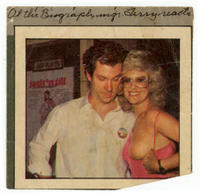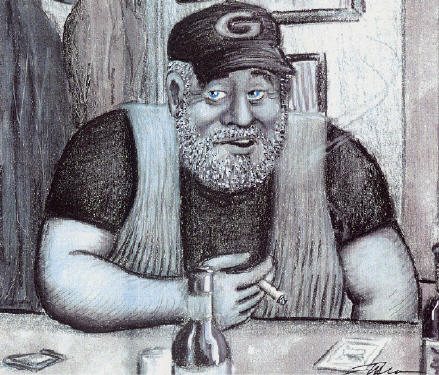Originally published by Brick Weekly in 2007
High on the Hog 1977-2006Due to the intrusion of an all-day downpour, last year’s edition of High on the Hog, No. 30, was a soggy affair. Two of the bands scheduled couldn’t play under the circumstances. Yet, in spite of the stormy weather, the Bopcats and the Memphis Rockabilly Band performed using a scaled down sound system. Tarps were lashed to the sides and back of the stage to block the wind-driven rain.
A few party stalwarts danced in the mud with umbrellas. The show went on … but perhaps for the last time.
“It was a Nor’easterner that settled over Richmond,” said the longtime director of matters musical, Chuck Wrenn. “We’ll see what the future brings.”
Meanwhile, there certainly will be no High on the Hog 31 this year.
So, the director of matters porcine, Larry Ham, won’t be slathering his Carolina red vinegar basting sauce over slow-cooking pork this Saturday in Libby Hill Park. Moreover, it seems likely that High on the Hog—which for three decades has served a generation as a reliable reunion party—has probably happened for the last time.
The heavy losses sustained from last year’s fizzler meant the handful of friends/neighbors who have staged and financially backed HOTH since its inception took a bath in red ink ... the rainy day fund was wiped out.
Going back to HOTH’s origins, other than Ham, among Wrenn’s chief co-conspirators have been: Bobby Long, Dave O’Kelly, John Cochran, Randy Smith and Steve McKay. For such veterans last year’s weather had to bring to mind another rainy day, 26 years before. 1980 was the year they significantly enlarged the plan for what had originally been a small annual neighborhood party.
Three rousing rock n’ roll bands played on a flatbed trailer in the cobblestone alley behind Wrenn’s 2808 East Franklin Street back yard for what was the then-largest HOTH crowd ever.
Yet, this was a time when one couldn’t get a permit from the proper authorities for such an event. Amplified rock simply wasn’t allowed at outdoor shindigs in Richmond, most especially on public property. So, in a sense HOTH 4 was flying below, or perhaps above, the radar. For whatever reason the cops on the beat chose not to bust it.
When it suddenly began raining in 1980, rather than lose momentum by shutting off the electricity and clearing the stage—to wait out the downpour—Wrenn broke out his staple gun and large rolls of heavy-gauge transparent plastic. With the help of volunteers an awning was hastily improvised to keep the rain off the stage. A portion of the yard closest to it was also protected, somewhat.
Then, with the electric guitars of Don’ Ax Me ... Bitch wailing in defiance of the chilly rainstorm, the sense of common purpose felt by those dancing in the mud was unforgettable. The full potential of live rock n’ roll music to simultaneously express both lamentation and celebration was realized.
In 1983 HOTH had outgrown its alley venue, so it shifted gears and moved into the park across the street. The throwdown even went legit. Subsequently, HOTH’s rollicking success and noteworthy lack of trouble planted the seeds for Jumpin’ in July, Friday Cheers and the outdoor music festivals that have blossomed since.
The HOTH record for beer sales on a Saturday afternoon still stands at 209 kegs; it was some time in the early ‘90s, according to Chuck. At its peak, it took some 350 volunteers to chop the pork, serve the beer, tend the stage, etc. Each year volunteers got a new HOTH T-shirt for their trouble; extras were sold to the public. There have been 25 different models.
What was a beloved local gospel group, The Silver Stars, holds the record for most HOTH appearances with 10 (1987-‘96). The Memphis Rockabilly Band played the gig seven times (1980, ‘81, ‘84-‘87, ‘06).
“The Silver Stars, we got every year we could ... until they died,” Wrenn recalled.
What were locally-based bands with multiple appearances include: The Bopcats, The Good Humor Band, Billy Ray Hatley’s bands, Page Wilson with Reckless Abandon and The Wall-O-Matics. Maybe the three most noteworthy national acts were: Billy Price and the Keystone Rhythm Band in ‘83 and ‘85; NRBQ in ‘87; Marcia Ball in ‘01.
Presented with the prospect that HOTH has run it course, a smiling Chuck Wrenn offered familiar advice, “Don’t forget to have a good time.”
Those coveted laminated backstage credentials, which meant free beer to the wearer, will probably be selling on eBay soon. Who knows what T-shirts will eventually be worth?
Appropriately, as it stands now, the last band to perform was the impeccably authentic Memphis Rockabilly Band. Although it was unplanned, they were the perfect act to play an encore for 30 years of smiles ... one last fast dance in the mud.
*
Originally published by Richmond.com in 2009
This View Is Our ViewAs I was walkin' - I saw a sign there
And that sign said - no tress passin'
But on the other side ... it didn't say nothin!
Now that side was made for you and me!
-- From Woody Guthrie's "This Land Is Your Land"
For a generation of music-loving Richmonders the second Saturday in October always meant another edition of High on the Hog -- the annual outdoor, pork-worshipping party staged in Libby Hill Park. The last of those rock ‘n’ roll themed parties was in 2006.
Over the 30 years of HOTHs, which functioned as reunions for regular attendees, some number of them must have paused over their barbeque sandwiches to appreciate Libby Hill Park’s famous elevated view of the James River winding away from Downtown Richmond toward the Chesapeake Bay.
Countless celebrations and festivities have taken place in that public park since its original days of being named Marshall Square, after Supreme Court Chief Justice John Marshall. Following the Civil War the name was changed to Libby Hill Park, after Luther Libby who lived adjacent to the park. Libby is remembered by history buffs for his nearby warehouse that was used by the Confederacy as prison during the Civil War.
Speaking of history, the story goes that in the 1700s the look of the James from what is now Libby Hill Park was so reminiscent of a similar view of the Thames in Richmond, England that Virginia’s capital city got its name from that resemblance.
With its 115-year-old Soldiers and Sailors Monument, rolling hills and quaint park house, Libby Hill Park has been the setting for countless picnic lunches and moonlit strolls. Tourist buses drive to the park religiously.
It’s all about The View.
Chuck Wrenn, the impresario who booked the entertainment for the HOTH parties, lives with his wife and two daughters on East Franklin Street, facing the park. “I was married in that park,” he said.
No doubt, many others are carrying memories of a special moment associated with the same vista.
HOTH parties, Frisbee-golf games and inner tube rides down snow-covered slopes aside, my own most vivid recollection of that park comes from a late afternoon with a girlfriend. In the early-1980s, for the benefit of my zoomed-in Super 8 lens, she was doing cartwheels, landing smoothly on her hands, then feet, then hands. As I panned to follow her, my camera angle had the shimmering light on the river in the background.
“This view belongs, not only to near-by residents, but to tourists and visitors from around the world,” said Tom Layman, who also lives close to the park.
Yes, the good folks who live in the houses closest to the park, like Chuck and Tom, have been happily sharing The View with the rest of us, all along.
Will that change soon?
Will a proposed condominium and hotel development, Echo Harbour, eventually be interposed between Libby Hill Park and the James River? Will old postcards, wedding photos and Super 8 clips be all that preserves The View for future generations to appreciate?
USP Rocketts LLC owns the land on which the proposed $160 million mixed-use project would be built on the riverfront. USP Rocketts LLC is based in Falls Church. Interestingly, it is a development company owned by the Unification Church founded by Sun Myung Moon.
The Unification Church also owns the Washington Times and a sprawling array of properties, nonprofit foundations and for-profit holding companies. Its worldwide holdings are vast and somewhat mysterious. Over the years, through various channels Moon’s money has been quite helpful to ultra conservative causes and politicians in America.
The City of Richmond’s plan for the site where the condos and such would go doesn’t call for buildings 10 to 14 stories tall. Current zoning doesn’t allow for such buildings. So, USP Rocketts needs the City to change its collective mind about what ought to happen on Dock Street.
A campaign to convince City Council to give USP Rocketts what it wants has been underway. The developers have pointed at the money Richmond should rake in from new tax revenues. They’ve talked about the jobs their project will create. There’s nothing new about that tactic. True or false, all developers sing that same basic tune when they want special favors from governments.
It’s then up to the government, in this case City Council, to decide what is the greater good.
If the City allowed a hog farm to be established where the GRTC bus barns are now that would create jobs, too. No doubt, the promoters of such a ridiculous notion could blue sky the story of how the hog farm would impact the neighborhood.
Ken Burns’ newest PBS documentary, “The National Parks: America’s Best Idea,” tells the story of how the USA wisely saw fit to protect some of its most beautiful views. Beginning with Yellowstone National Park, in 1872, America led the world in establishing parks owned by rich and poor citizens, alike, and protected by the government.
Isn’t Richmond looking at the same sort of problem America faced when it opted to establish national parks, rather than let hard-charging developers build whatever they liked and put up no trespassing signs?
Boiled down to its essence, it’s a choice: Should Richmonders go on preserving a cherished view of the James River that benefits the entire community? Or, should we stuff more money into the Unification Church’s coffers, hoping a few bucks fall our way?
Wasn’t this spectacular view of our river made for you and me?
-- 30 --








